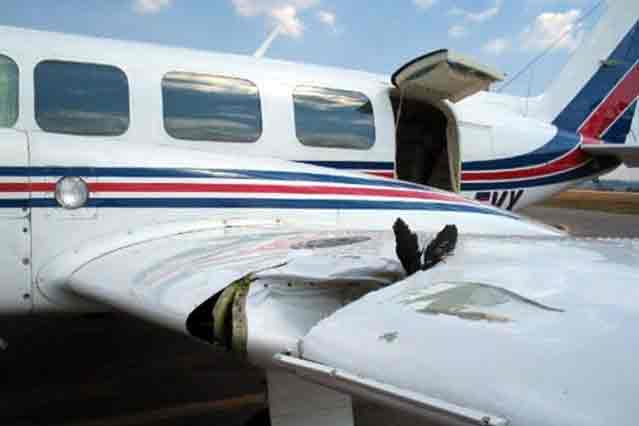In this part, you will tell me what you can see in this picture and what you think is happening in it. After that, I will ask you some questions. Look at the picture carefully. You may take a few moments to think before you start talking.
Are the instructions clear?
SUGGESTED INTERACTION: This picture shows me a light twin piston engined aircraft which might be parked at the apron.
The leading edge of the aircraft wing is torn with a bird remains certainly caused by the impact of a bird strike.
Incident like this is most likely to happen during takeoff, initial climb, approach and landing phases.
And detailing this photo further, it is possible to observe that the rear door is open, wherein the passengers could have disembarked without injuries.
Soon, the maintenance staff will take the measures of repairs for this situation.
Examiner: What do you think happened before this picture was taken?
SUGGESTED INTERACTION:
ICAO 5: Well, prior to the capture of this image, I believe that the pilots must have been approaching to land and out of the blue, suffered a collision with a bird, with no chance to deviate.
ICAO 4: Before this photo was taken I think the pilots were approaching to land and had a bird strike.
Examiner: What do you think will happen next?
SUGGESTED INTERACTION:
ICAO 5: Next, with a massive damage like this, certainly the aircraft will be taken to the hangar to go through maintenance and later she will be brought back to operations as soon as possible or she might even be written off. No one knows, depending on the circumstances.
ICAO 4: Next, the aircraft will be taken to the hangar for maintenance and later she will come back to the operations.
ICAO 4: Next, the aircraft will be taken to the hangar for maintenance or be written off.
Examiner: What may happen if a seagull strikes an aircraft windshield after takeoff?
SUGGESTED INTERACTION:
ICAO 5: If the aircraft is a light one like that, it may shatter the windshield and the bird can break into the cockpit causing pilot incapacitation.
However, if the bird hits the windshield of a larger and heavier aircraft, because it has a more reinforced windshield, it can only bring about cracks, leading the pilots to come back to the airport for assistance.
ICAO 4: If a seagull hits the aircraft windshield after takeoff, it can shatter the windshield by breaking it into the cockpit, causing pilot incapacitation.
Examiner: How do airports mitigate the risk of bird strikes?
SUGGESTED INTERACTION:
ICAO 5: There is an assortment of methods to mitigate the risk of bird strikes, but not all the airports use them.
First of all: Wildlife Management Programs: Airports often develop wildlife management programs that include regular monitoring and assessment of bird populations in and around the airport.
Habitat Modification: Airports may modify the airport environment and surrounding habitats to make them less attractive to birds.
Acoustic Deterrents: Some airports use sound systems that emit distress calls or predator noises to deter birds from the immediate vicinity.
And there’s also the hawks which are trained to scare birds away; and together this, there is an innovative technology: a drone in the shape of a hawk to fly around the airport scaring birds away.
ICAO 4: First of all, there are many ways to mitigate the risk of bird strikes, For instance:
– Firstly, The administration of the airport can use birds of prey and fireworks to keep the birds away from the vicinity of the airport.
– Secondly, Cutting the grass in order to keep clean all the airport area. (Mow the lawn to keep the entire airport area clean)
– And finally, getting rid of all the dumping ground close to the airport.
Now, I am going to read a statement to you and then you will have to tell me to what extent you agree or disagree with it.
“Bird strikes are a bigger problem today than there used to be thirty years ago because of environmental laws, which made the number and size of protected wildlife areas increase and consequently, the number of birds.”
SUGGESTED INTERACTION:
ICAO 5: I partially agree with this statement because the increase in bird strikes is not solely attributable to the increase in the number of protected wildlife areas, but is also influenced by the rise in air traffic.
Not to mention that, it should be noted that the population has increasingly encroached upon areas near airports, resulting in greater human waste accumulation, which in turn attracts more birds to these areas.
Thirty years ago, there was significantly less air traffic compared to today, as many airports were typically located farther away from urban areas. Additionally, hunting seasons were often allowed to help manage bird populations.
ICAO 4: I agree in part with this statement because the increase of bird strike is not due to the large number of protected wildlife areas, but due to the increase of air traffic around the world, and in addition, there are other things that attract birds to the vicinity of the airport and one of them is the increase of dumping Grounds caused by the increase of the city.
Se você gostou desse post do Call to Fly, compartilhe utilizando os canais de Mídia!!
Abraço!! Rumo ao topo!
Leandro Araujo
